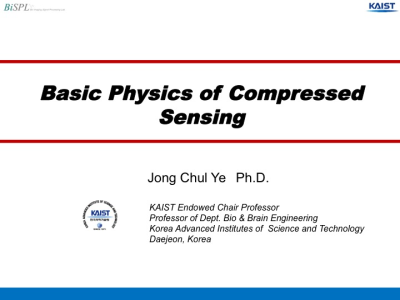|
Sunrise Session
Go Faster in Clinical Imaging: Compressed Sensing |
|
Go Faster in Clinical Imaging: Compressed Sensing
Sunrise Session
ORGANIZERS: Jongho Lee, Utaroh Motosugi, Yi-Fen Yen
Monday, 18 June 2018
| N04 |
07:00 - 07:50 |
Moderators: Utaroh Motosugi, Yi-Fen Yen |
Skill Level: Basic
Session Number: S-M-03
Overview
This session introduces fast imaging techniques that are becoming available in the clinic. Four cutting-edge techniques - compressed sensing, synthetic MRI, multiband imaging, and fingerprinting -will be covered one in each day. The background physics and clinical applications will be discussed.
Target Audience
Medical doctors who are interested in fast imaging and physicists who are interested in clinical applications.
Educational Objectives
As a result of attending this course, participants should be able to:
-Describe the basic physics of each method: compressed sense, synthetic MRI, multi-band imaging and fingerprinting; and
-Discuss how each method impacts clinical imaging.
07:00
|
 |
 Basic Physics of Compressed Sensing Basic Physics of Compressed Sensing
Jong Chul Ye
Compressed sensing have been extensively investigated as a means to accelerate the MR acquisition by exploiting the redundancy in spatial domain. In this presentation, I will first review the basic principle of compressed sensing and recent development. Then, I will provide a unified view of the compressed sensing, parallel imaging and recent structured low-rank matrix approaches for accelerated MRI. More specifically, inspired by k-space interpolation methods, an annihilating filter based low-rank Hankel matrix approach (ALOHA) is proposed as a general framework for sparsity-driven k-space interpolation method which unifies pMRI and CS-MRI. This converts pMRI and CS-MRI to a k-space interpolation problem using a structured matrix completion. In addition, it provides an important link to the recent deep learning approaches for accelerated MRI.
|
07:25
|
|
 Clinical Applications of Compressed Sensing Clinical Applications of Compressed Sensing
Akira Yamamoto
Through these clinical MR images, we try to explain three key elements essential for compressed sensing. The first is sparsity, the second is random sampling, and the third is nonlinear iterative image reconstruction. Since all of these keywords are unfamiliar to clinicians, we will try a simple and intuitive explanation that clinicians can understand necessity of these three elements by using MR image obtained with compressed sensing.
|
07:50
|
|
Adjournment & Meet the Teachers |
|
| Back |
| The International Society for Magnetic Resonance in Medicine is accredited by the Accreditation Council for Continuing Medical Education to provide continuing medical education for physicians. |


